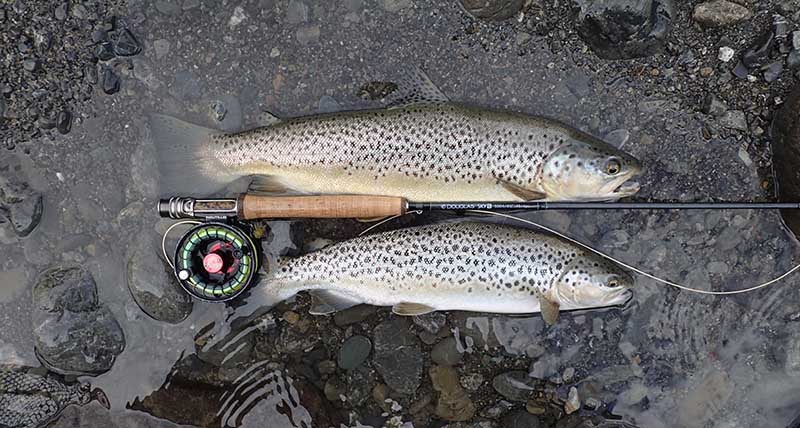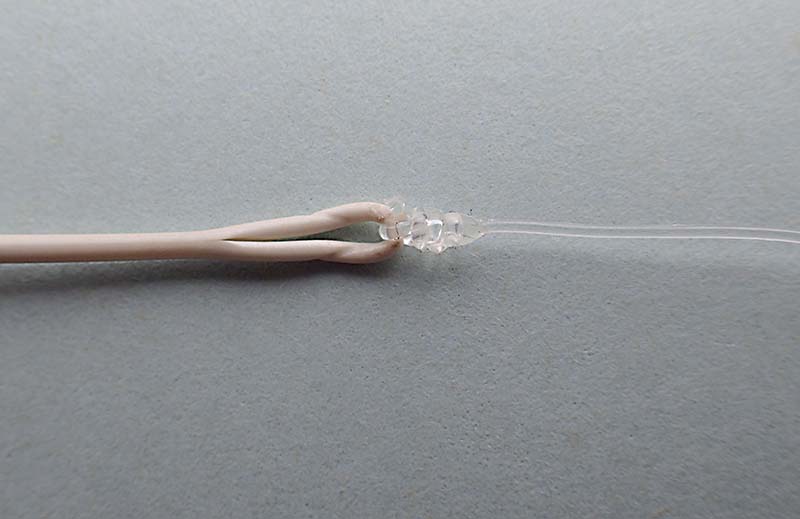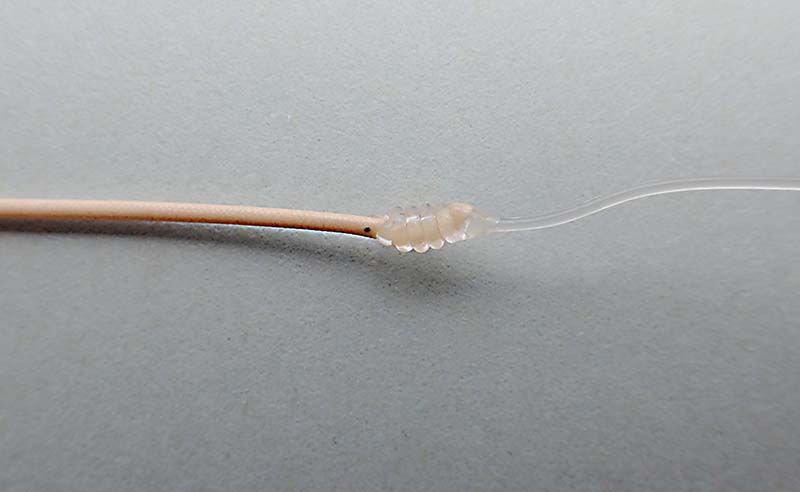No matter how good your rod or fly line, if a leader is not designed for your fishing situation you will struggle to catch fish.
On New Zealand rivers, long leaders are used to cast to spooky trout in gin clear water to keep the fly line away from the fish. Long leaders are also necessary to turn over large dry flies and heavy nymphs with indicators, which is a lot to ask from a 15 ft leader powered by a 5wt fly line.
14 foot Presentation Leaders
I’ve tested a lot of leaders over the last two decades for casting big cicadas and nymphs to backcountry trout, and find the 14 foot 3X Scientific Anglers Absolute Trout Presentation leaders to be the best for this purpose. This leader and the 5wt Scientific Angler's MPX fly line make an exceptional combination for fishing cicadas on bush streams. See my 'Bush Stream Cicada Season' article I provide a link to at the end of this article.
What first struck me about the 14 foot SA Presentation Leaders was how thick the butt sections were - much thicker than those of other leaders I’ve used - and too thick I thought for a 5wt line. But it took only a cast or two to appreciate how much better they are at turning over large cicada patterns and heavy nymphs, which had me rethinking my ideas on leader design.
Basic physics dictates that to deliver large dry flies or weighted nymphs on a long leader one needs a long and heavy butt section, with an aggressive/short taper to transfer as much energy as possible from the fly line to the fly. According to the great Flip Pallot, the butt should be slightly stiffer than the tip of the fly line. It’s best to achieve the required stiffness with a thicker more supple monofilament than a thinner stiffer one, as the thicker material has more mass and therefore transfers more energy.
Some argue that a thinner stiffer line will have less wind resistance, which is true, but as a line of the same material becomes thicker the surface area to volume/mass ratio decreases, which makes it more efficient for casting into the wind. Try casting a 2wt and a 7wt fly line into the wind and you’ll appreciate what I mean.
SA Presentation leaders are constructed from a copolymer blend designed to be supple for drag free drifts, which is why the butts are so thick and they perform as well as they do.

11 foot Presentation Leaders
The 11 foot SA Presentation Leaders are great for casting smaller dry flies (#12 and smaller) and indicator nymphing on lowland rivers and streams - pairing very well with a SA infinity and Creek Trout fly lines.
The butts on the 11 foot presentation leaders, while thicker than average, are noticeably thinner than on the 14 ft leaders; because less energy is needed to turn over a shorter leader, and too much energy transferred from the fly line will spoil presentation.
Unlike the 14 foot leaders, the diameter of the butt sections on the 11 foot leaders varies according to the tippet diameter, as less energy is necessary to turn over smaller flies and smaller flies are used on finer tippet.
Attaching long leaders to the fly line
There are several methods for attaching a leader to a fly line and each method influences overall performance of a long leader.
While the SA Trout Presentation Leaders come with a perfection loop tied in the butt end, I don’t recommend attaching a long leader to a fly line with a standard loop-to-loop connection because this clunky connection sticks in the guides with the following drawbacks:
| - | When spotting a fish it takes more time to coax the fly line through the tip guide to make a cast, which is both irritating and results in lost opportunities. |
| - | When landing fish it’s necessary to retrieve the connection into the guides, which not only feels clunky but results in broken tippets as large back country trout make an inevitable dash each time they come near the net. |
I recommend the following connections, both of which require cutting the loop of the butt of the leader:
| - | Use a clinch knot to tie the leader to the loop in the fly line. |
| - | Cut off the loop in the fly line and tie the leader to the fly line using a snell knot. |
| - | A small drop of Loon UV Knot Sense at the front of the knot will make for even smoother transition for both knot types. I don’t recommend coating the knot as this increases the thickness of the knot, which is counter productive. |

Clinch knot:
An 11 foot 3X SA Absolute Trout Presentation leader attached to the loop of a 5wt fly line with a clinch knot. A small drop of Loon UV Knot Sense is applied to the leader just in front of the knot.

Snell Knot:
A 14 foot SA Absolute Trout Presentation leader attached to a 5wt fly line with a snell knot. A tiny drop of Loon’s UV Knot Sense was applied to the leader just in front of the knot to smooth the transition.
Once the snell knot is completed it looks like a nail knot, but the method for tying it makes it much stronger because it crimps onto the fly line core and is less prone to failure by coming away with the fly line coating.
Mad River outfitters have several good videos on the snell knot connection that Flip Pallot and Lefty Kreh have used for decades when fishing large salt water predators. Flip uses seven turns when tying the snell knot to the tip of a mono-core salt water fly line although I find that five turns works best for attaching a 14 ft Presentation leader to a SA braid core fly line.
The snell knot provides so little resistance I can cast it out through the guides, and when landing fish if feels as though the leader and fly line are continuous. The down side of the snell knot is that you cannot change leaders. If you think you are going to need to change leaders regularly, the clinch knot is the way to go.
Since welded loops create some weight at the tip of fly line, they provide a slight hiccup in the transfer of energy from the fly line to the fly. For this reason some anglers remove the welded loop and then whip an ultra-small loop at the tip of the fly line, using the stripped fly line core. The leader is then attached to the small loop with a clinch knot, creating a smoother transition of energy, as well as moother passage through the guides.

Whipped loop:
A leader attached to a small whipped loop in a SA Euro Nymph fly line using a clinch knot.
Adding tippet
Once the leader is attached to the fly line I trim away most of the 3x tippet section, leaving about six inches, and then attach a tippet ring. I then attach 4x fluorocarbon to the the tippet ring, 3 feet for fishing large dry flies or 1.2-1.5 times the depth of the water if nymphing.
When nymphing, I attach a small poly yarn indicator to the leader just above the tippet ring. If I’m using a dry/dropper system I use the dry fly setup and attach a couple of feet of 5x tippet to the bend of the dry fly.
Some cheap tippet rings are almost square in cross section and the corners not only make tying a clinch knot difficult, but also damage to both leader and tippet making te first one or two centimetres squiggly. For this reason, I highly recommend Scientific Anglers tippet rings as they are oval in cross section and easy to knot.

Final word
Scientific Anglers Absolute Trout Presentation Leaders have been a small revelation on my trout fishing journey - they've definitely made me a better New Zealand angler and casting long leaders much more fun, especially if I attach them using the methods described.
See :
| + | Bush Stream Cicada Season Fishing |
|---|---|
| + | Designing the Silicone Wing Cicada Fly |
| + | Tying the Silicone Wing Cicada Fly |
